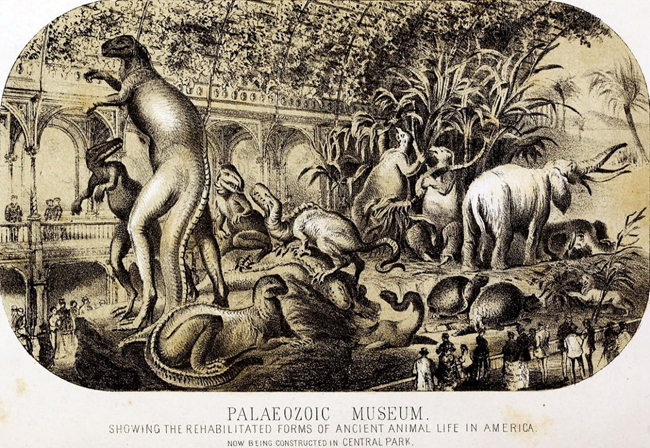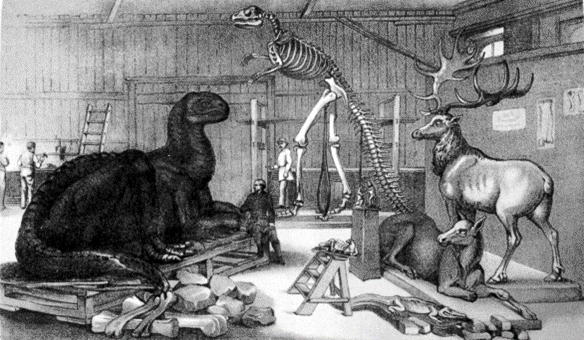Thanks to researchers from the University of Bristol, the culprit behind the infamous destruction of New York’s first life-size dinosaur theme park has been revealed. A New York museum mystery has been solved.
A new paper from the University of Bristol documents the bizarre case of the destruction of prehistoric animal figures destined for New York’s Central Park. The research team have shed light on one of the strangest and most puzzling events in the early history of palaeontology.
In May 1871, the partially built, life-size models of prehistoric creatures including several dinosaurs, being created for a new museum were totally destroyed in an act of malicious vandalism by a gang of thugs armed with sledgehammers. The remains were carted away and buried somewhere in the park. They have not been found to date.

American Politician William “Boss” Tweed Not Involved
It had been widely thought that the destruction of the statues was ordered by the notorious American politician William “Boss” Tweed.
In the new paper from Ms Victoria Coules of Bristol’s Department of History of Art and Professor Michael Benton of Bristol’s School of Earth Sciences, the politician is exonerated. New light on this bizarre episode has been shed. Contrary to previous accounts, it was the Treasurer and Vice President of the Central Park, Henry Hilton who most likely, organised the vandalism.
Ms Coules commented:
“It’s all to do with the struggle for control of New York city in the years following the American Civil War (1861-1865). The city was at the centre of a power struggle – a battle for control of the city’s finances and lucrative building and development contracts.”
A New York City Power Struggle
As the city expanded, the iconic Central Park was taking shape. It was to be more than just a green space. It was to have other attractions, including the Palaeozoic Museum. Benjamin Waterhouse Hawkins, a famous British sculptor who had created the Crystal Palace Dinosaurs, the life-size models of prehistoric creatures in London – had travelled to the USA to build American versions of the animals.
However, the notorious William “Boss” Tweed had taken control of the city and, in sweeping changes to the city’s management, put his own henchmen in charge of city departments, including Central Park. They cancelled the partially complete project in late 1870. There the matter would have lain but in May 1871 someone ordered a gang of workmen to smash all of its partly finished contents.
Professor Benton (University of Bristol) explained:
“Previous accounts of the incident had always reported that this was done under the personal instruction of “Boss” Tweed himself, for various motives from raging that the display would be blasphemous, to vengeance for a perceived criticism of him in a New York Times report of the project’s cancellation.”

Things Did Not Seem Right
Ms Coules added that when reading the reports, suspicions were raised. At the time, Tweed was fighting for his political life having already been accused of financial impropriety. Why would he have got himself involved in a museum project?
The research team examined the original sources and discovered that the culprit was not Tweed.
“The motive was not blasphemy or hurt vanity”.
A Complicated New York Museum Mystery
The situation was complicated by two other projects in development at the same time in Central Park. The building of the American Museum of Natural History and the Central Park Zoo.
Professor Benton explained:
“Drawing on the detailed annual reports and minutes of Central Park, along with reports in the New York Times, we can show that the real villain was one strange character by the name of Henry Hilton.”
Ms Coules stated that with the primary information sources available on-line, the researchers could study them in detail. They were able to demonstrate that the destruction of the prehistoric animal statues was ordered by Henry Hilton. He was the Treasurer and Vice President of Central Park.
Hilton was already infamous for other eccentric behaviour. For example, he ordered a bronze statue in the Park painted white. When the skeleton of a whale was donated to the American Museum of Natural History, he ordered that painted white too.

Picture credit: Everything Dinosaur
The picture above shows one of the Crystal Palace prehistoric animal statues. This is the Megalosaurus. Like the other sculptures at Crystal Palace, it is a Grade I listed building.
For more accurate models and replicas of Megalosaurus and other theropods: Dinosaur Models Natural History Museum.
Summing up this bizarre tale, Professor Benton concluded:
“This might seem like a local act of thuggery but correcting the record is hugely important in our understanding of the history of palaeontology. We show it wasn’t blasphemy, or an act of petty vengeance by William Tweed, but the act of a very strange individual who made equally bizarre decisions about how artefacts should be treated – painting statues or whale skeletons white and destroying the museum models. He can be seen as the villain of the piece but as a character, Hilton remains an enigmatic mystery.”
Everything Dinosaur acknowledges the assistance of a media release from the University of Bristol in the compilation of this article.
The scientific paper: “The curious case of Central Park’s dinosaurs: The destruction of Benjamin Waterhouse Hawkins’ Paleozoic Museum revisited” by Victoria Coules and Michael J. Benton published in the Proceedings of the Geologists’ Association.
Visit the award-winning Everything Dinosaur website: Everything Dinosaur.






Leave A Comment